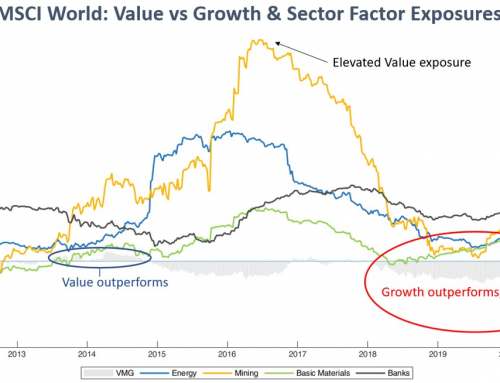The 2017 Financial Year was a rewarding one for Australian equity investors; a revival in commodity prices saw the resources sector generate 21.5% over the last 12 months. Indeed, all sectors except for telecommunications generated positive returns for the financial year with most sectors generating double-digit returns. Global equity markets also performed solidly; Asian markets were up by more than 20%, as was most of Europe, and the US was not far behind. Not bad considering investors were faced with the potential negative impact of the Brexit vote, Trump victory, US rate hikes, North Korea stepping up its missile tests, China moving to put the brakes on its economy amidst ever present concern about its debt levels, and subdued growth in Australia along with perennial fears of a property crash and banking crisis. Despite these concerns, equity markets continued their upward trajectory, stretching valuations above their long term averages. Are equity markets over optimistically heading into 2018 or are these valuations justified in a low inflationary environment?
Differing views…
Australian equity manager, Roger Montgomery believes that the risks weigh heavily on the downside; he believes that elevated share prices imply strong earnings growth and that growth is becoming much more difficult for several key economic sectors. Furthermore, rising non-discretionary household costs combined with weak wages growth leaves less discretionary spending capacity. As such, discretionary retailers and product manufacturers are vulnerable to weakening demand. Conversely, Shane Oliver, the Head of Investment Strategy and Economics and Chief Economist at AMP Capital believes that the combination of reasonable global growth, solid profit growth and still easy monetary conditions suggest solid returns for diversified investors, albeit not as solid as FY2017. (We note that the Morningstar Balanced Index – a proxy for Balanced funds -generated a return of 6.5% for FY2017, which suggests that a solid return under a low return world is considerably less than the experience of the last few decades).
A relatively sanguine Ben Bernanke…
The DFSPS team recently attended an event hosted by Pimco which included a Q&A forum with Ben Bernanke, former Chairman of US Federal Reserve. His views on financial markets were rather sanguine, with an inference that financial markets are unlikely to crash and returns (due to low yields and elevated equity valuations) will be subdued. Ben Bernanke offered his views on the following issues:
On the US Fed v ECB: the US Fed is in a better situation than the ECB, as the trajectory of its monetary policy is well ahead of the ECBs and that the Fed is likely to raise rates in December and a further 2 times over 2018. Communication and forward guidance from the US Fed & ECB will continue as they deliberately target a steady and measured tightening process. Even so, US monetary policy will have insufficient fire power in the event of deflationary pressures and government fiscal support will be required to stabilise the economy.
Probability of US recession: Ben Bernanke assigned 2/3rds probability that the US will break its previous record of 11 years of continuous economic expansion (i.e. another 2 odd years).
On the Trump rally: Ben Bernanke believes it is largely overdone and the tax cuts required to fund Trump policies are uncertain, given the lack of support among Republicans as affirmed by the failure of Obamacare Repeal Bill. Tax cuts are likely to be delayed and significantly smaller and will not have as much stimulatory impact as initially envisaged.
On Trade & Foreign Policy: Trade policy should be rather benign; the proposed changes to NAFTA for example are not radical – however Trump’s foreign policy has the potential to be radical. Ben Bernanke qualified that trade policy should remain benign provided that President Trump does not use Trade policy to influence foreign policy.
On Trump talking down USD: Trump may take a little credit to improve US trade; however the majority of recent USD weakness is due to inflationary expectations being revised down and subdued growth in wages. Productivity growth has been lower than even the most pessimistic forecasts (which has not helped on the wage growth front) for which he expects some mean reversion to come through.
On the next US Fed Chair: favours Yellen to continue on, however likely that Gary Cohn as Chair early next year. Irrespective of who is appointed, Ben Bernanke does not project any big shifts away from Yellen’s trajectory.
On Quantitative Easing: US Fed balance Sheet has expanded from USD1 trillion to USD4.5 trillion and expects this to reduce to USD3 Trillion over the next 3½ years, comprising ~$1.8 of trillion treasuries and ~$1.2 trillion of mortgage backed securities. Currency itself has increased to USD1.5 Trillion, so the QE unwind will not get back to USD1 Trillion.
On China: he does not see significant downside risk as China does not issue in foreign currency and has reasonable control of the financial system. However, he expects downward pressure that will lead to a slowing and more volatility in economic growth as it transitions to a more market oriented economy.
DFSPS Portfolio positioning
Market conditions continue to be stable with equity risk falling to extreme low levels. While our risk signals suggest tilts to risk assets to take advantage of current conditions, we believe potential risks remain elevated. As such, we maintain a neutral allocation to growth assets across our risk-averse portfolios (Conservative to Balanced). In contrast, our risk-seeking portfolios (Growth & High Growth) are overweight growth assets. In terms of exposure to growth assets, we favour European and emerging equity markets over Australian equities, REITs and Infrastructure. Across the spectrum of defensive assets, we remain strongly underweight duration, overweight Cash and neutral Credit and Alternatives. Importantly, we will re-balance portfolios to stabilise risk as meaningful turbulence in market risk factors are observed to reduce the potential of large draw-downs.
Disclaimer






